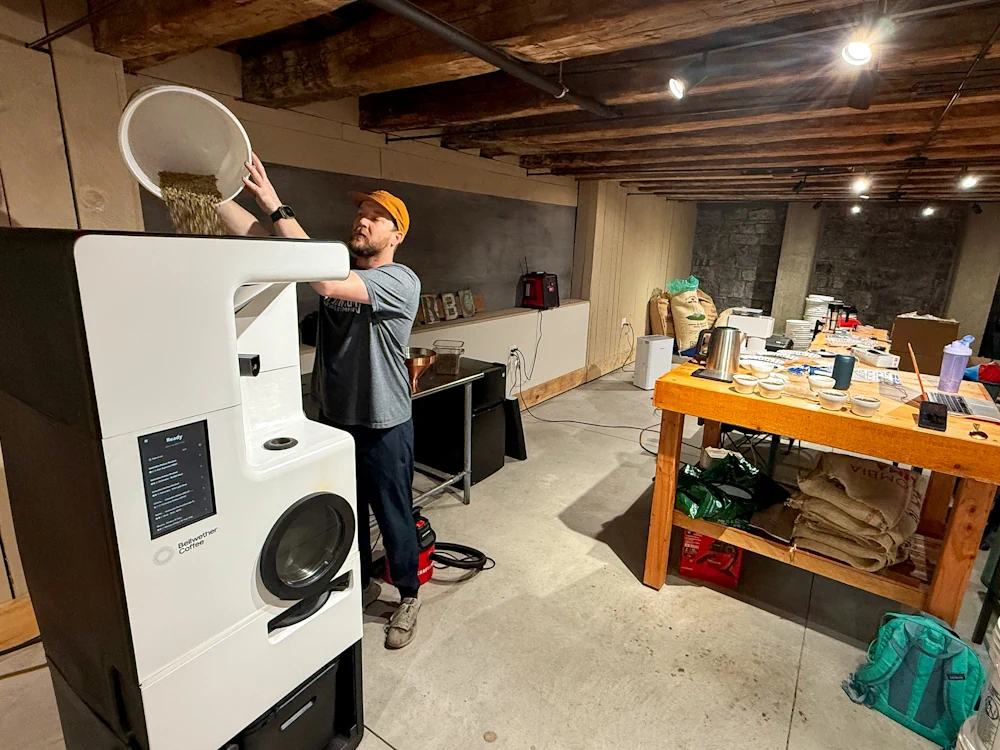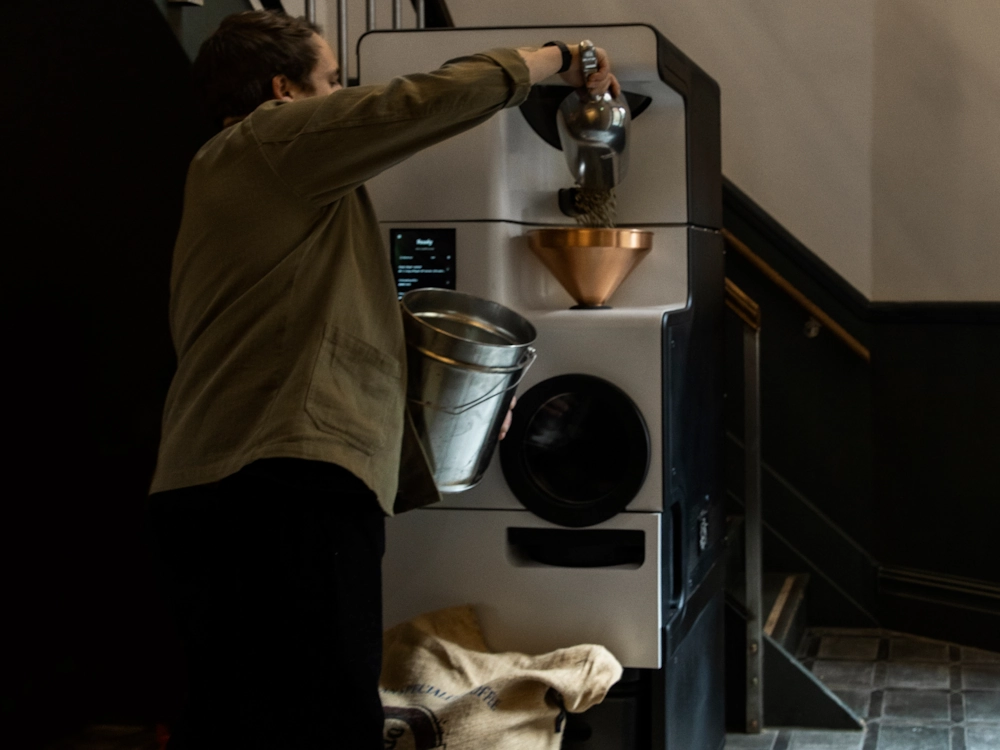Why roasters are demanding more from their machines
It has been a challenging few years for coffee roasters, and there’s little sign of relief on the horizon. Green coffee prices have remained high and volatile, and so has the cost of everything else, including packaging, transport, energy, and labour.
With margins and cash flow stretched thin, a machine that just roasts coffee is no longer enough; today’s roasters are increasingly demanding more from their equipment. They’re looking for systems equipped with high-performing software and technology, as well as comprehensive support, to help improve quality, streamline operations, and reduce costs.
I spoke to Doug Hewitt at 1951 Coffee Company and Gabriel Boscana at Bellwether Coffee to learn how new demands from roasters have influenced roasting technology and the services that manufacturers offer.
You may also like our article on how to start a microroastery.

Roasters are facing new challenges
Coffee roasters are under more pressure than ever, especially due to rising costs across the entire value chain. Green coffee prices have more than doubled over the last year. In 2024, arabica futures increased 70% to their highest levels since 1977, while robusta prices reached all-time highs.
These price surges stem from low crop yields in Brazil and Vietnam, growing uncertainty surrounding the EU’s impending deforestation regulations, and logistical disruptions, such as the temporary closure of ports in Djibouti, a key transit point for Ethiopian coffee.
In response, more coffee businesses are exploring in-house roasting as a way to regain control over quality, pricing, and sourcing. To support this trend, Bellwether Coffee, which will exhibit at WoC Geneva at booth #1422, created an ROI Calculator to help retailers analyse the costs and benefits of roasting their own coffee.
Price volatility has continued into 2025, with the new floor for the C market now estimated at around US $4/lb. Inflated pricing has left many coffee roasters with shrinking cash reserves, making it difficult for them to continue operations as usual.
Roasters who haven’t hedged their coffee purchases, locking in prices ahead of time, are especially vulnerable to sharp price increases. While larger roasters are somewhat protected by scale and buying power, the price hike is more concerning for smaller roasters that can’t buy in bulk and operate on a shorter-term basis.
Logistical hurdles persist
Rising costs across the board, including transport, storage, and energy, exacerbate the situation. Freight rates have surged, warehousing expenses are up as roasters are forced to hold onto inventory for longer, and tariffs in countries like the US have increased significantly.
For example, the US currently has a 10% “baseline” tariff on almost all imports. Some countries (including major coffee-producing nations like Vietnam and Indonesia) are potentially facing even higher rates, despite the lack of a domestic alternative. As a result, US roasters are likely to pay anywhere from 10% to 35% more for green coffee.
Energy costs are also expected to rise by 7% in the US and other regions, while global inflation rates have remained high since the pandemic. Most roasters can’t afford to absorb these increased costs, and are considering retail price hikes and rethinking their sourcing strategies to stay competitive.


A growing demand for more than just a roasting machine
Roasters typically operate on tight margins for a few reasons, including high (and volatile) green coffee prices, rising operational costs, and the need for highly specialised equipment.
Coffee roasting equipment, in particular, is a significant investment, and with costs rising, the decision to purchase a new machine is more crucial than ever.
“The Bellwether Shop Roaster, for example, is an all-electric, ventless, and automatic countertop machine that doesn’t require gas lines or construction,” says Gabriel Boscana, a green coffee buyer at Bellwether Coffee. “It can roast up to 1.5kg per batch, with three to four roasts per hour. This means you can roast 20 kg in up to 4.5 hours, allowing for even greater daily output depending on how long you operate the roaster.
To cope with additional pressures, many roasters are no longer interested in machines that only roast – they want modern systems that offer advanced software and technology, as well as unique features that support their entire roasting operations.
“With the Continuous Roasting Upgrade, you can load enough green coffee for up to 13 consecutive batches,” Gabriel adds. “In under 4.5 hours, the machine can roast 20kg of coffee with no intervention – just unload the roasted coffee and reload green coffee for another cycle. In a standard nine-hour shift, you could roast up to 40kg with only a few minutes of labour required.”
“We only had to install a new plug receptacle in the café, and we were ready to go,” says Doug Hewitt, the CEO of 1951 Coffee Company, a roaster in Berkeley, California that supports refugees with access to barista training programmes. “It was easy to find space to place the roaster, and we didn’t have to worry about permits to install ventilation. It takes up to two minutes of manual labour to set up a roast.”
The push for greater sustainability in roasting
Today’s consumers are increasingly choosing to support brands that prioritise sustainability. When it comes to coffee, 43% of consumers say their choices are influenced by “ethical, environmentally friendly, or socially responsible options”.
However, the worsening climate crisis poses a threat to the future of the coffee value chain. The Intergovernmental Panel on Climate Change (IPCC) warns that nearly half of the world’s coffee-growing land could become unproductive by 2050, with yields dropping as much as 70%.
Coffee roasting is a known contributor to this problem. Traditional gas-powered roasters release significant amounts of carbon dioxide, methane, and other volatile organic compounds (VOCs) that contribute to global warming.
Given the growing consumer demand for sustainability and the looming climate crisis, coffee roasters must seriously consider the environmental impact of their equipment.
For instance, all-electric machines, like Bellwether, can reduce a roaster’s carbon footprint by up to 87% compared to gas-powered systems.
“As a nonprofit social enterprise working with immigrants, we know that climate change is one of the main driving factors in human migration and global conflicts,” Doug says. “Being able to minimise our impact on global warming is essential to our overall mission.”
Doug adds that 1951 Coffee Company is 100% solar-powered and emphasises that Bellwether’s low-emission roaster helps reduce the company’s carbon footprint.
Adopting more eco-friendly practices isn’t just positive for the environment, but it’s also an effective cost-saving measure. Electric roasters can reduce waste and eliminate fuel costs, helping pad roasters’ bottom lines.


New levels of support for coffee roasters beyond equipment
As roasters increasingly demand more from their machines, modern coffee roasting equipment now incorporates additional features to make sourcing and roasting high-quality coffee more accessible.
For example, Bellwether’s Roast Manager consolidates roasting operations across multiple locations into one cloud-connected interface. Roasters can use this platform to create, clone, and customise roast profiles, analyse roast history, access a library of support resources, and review maintenance tasks.
“I have used the Roast Manager to monitor the amounts of each type of coffee we roast, machine operations, and troubleshooting,” explains Doug. “I often get pulled in a lot of directions, but being able to respond to team inquiries with up-to-date information anywhere I am is helpful.”
Another support feature roasters can leverage is Bellwether’s Green Coffee Marketplace, which helps roasters source high-quality green coffee lots and provides pre-developed roast profiles tailored to each coffee.
“The Shop Roaster itself is easy to use and intuitive, and we guide customers through the process from green coffee selection from our marketplace to profiling the roasted product,” says Gabriel.
“We offer profile suggestions and full traceability of the coffees available on the marketplace,” he adds. “We also provide suggestions as to which coffees to start the roasting journey with and how they might work in blends.”
The platform also supports ethical sourcing through Bellwether’s Living Income Pricing, which pays producers 50% more than Fairtrade coffee prices and 78% more than commodity prices. Roasters, in turn, gain farm-to-cup transparency, ensuring higher standards for farmer equity.
“A small company like ours doesn’t have the resources to put toward a green coffee buyer or the time to travel to farms to build relationships and know that we’re sourcing quality coffee with a positive impact on producing communities,” says Doug. “Instead, we have to rely on the stories and details about the producing communities so we can research and see the impact our coffee purchases are making.”
How modern solutions are supporting roasters
As coffee roasters continue to grapple with rising costs and customers become increasingly price-conscious, they must balance cost-cutting measures without compromising on quality or flavour.
Fortunately, new roasting technologies are making this task easier to achieve, helping roasters improve quality and streamline operations, both of which mitigate the effects of increased costs.
By utilising integrated roasting systems, roasters can reduce overhead costs, closely manage their supply chain, and gain greater control over their coffee quality. The Bellwether Marketplace, for instance, enables roasters to purchase 10kg (24lb) boxes or full bags of green coffee through direct trade.
“Roast profiles are built in, which saves roasters from spending time tweaking their recipes and going through bags of green coffee, which is another expense,” explains Gabriel. “Especially now, with all costs becoming more expensive, controlling the cost of your raw material is a huge boost to a brand and business.”
Doug notes that in-house roasting has helped him reduce waste and improve inventory management. Bellwether’s ROI calculator enables coffee business operators to better understand the costs and benefits of in-store roasting.
“When we were a wholesale account, we always had to try and predict the ebbs and flows of business, but always seemed to have some coffee that would be reaching the end of its quality date,” he says. “Roasting coffee ourselves allows us to have wholesale and online retail options to keep inventory moving and refreshed.”
Modern roasting systems also offer automated features that help free up staff and reduce human errors, minimising waste and labour costs. For example, the Shop Roaster’s Continuous Roasting Upgrade includes a green coffee autoloader with a 20kg capacity and a storage base for roasted coffee. These features help boost productivity by allowing staff to focus on other tasks, rather than constantly monitoring the machine.


As costs continue to rise across every part of the coffee supply chain, staying profitable is becoming harder, especially for roasters already operating on razor-thin margins. In today’s climate, roasters will continue to seek out equipment that goes beyond just roasting coffee to combat this.
Looking ahead, we can expect to see a rise in roasting systems that offer greater sustainability, automated features, and support that extends beyond the machine itself.
These advancements won’t just help roasters weather tough conditions; they’ll also allow roasters to effectively cut costs, maintain high-quality standards, and build more efficient and scalable roasting operations.
Enjoyed this? Then read our article on how micro roasters paved the way for in-store roasting.
Photo credits: Bellwether Coffee
Perfect Daily Grind
Please note: Bellwether Coffee is a sponsor of Perfect Daily Grind.
Want to read more articles like this? Sign up for our newsletter!
Source: Perfect Daily Grind



